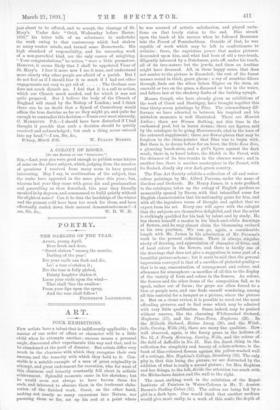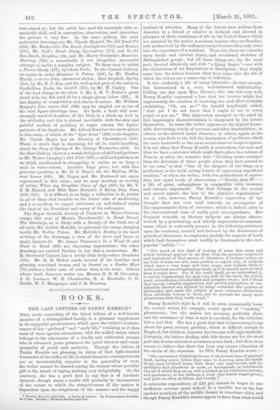ART
FOUR EXHIBITIONS.
FEW artists have a talent that is indifferently applicable; the master of one order of effect or character will be a little child when he attempts another; success means a personal angle, discovered after experiments this way and that and to he abandoned at the peril of disaster. But artists differ very much in the clearness with which they recognise their own Success, and the tenacity with which they hold to it. Con- Stable isis a notable example of a man of great originality in attempt, and great endowment for execution, who for want of this clearness and tenacity constantly fell short in artistic achievement. Splendid moments came in his sketches ; but he would seem not always to have known them for such, and laboured to obscure them in the irrelevant elabo- ration of the finished work, Corot, on the other hand, making not nearly so many excursions into Nature, nor pursuing them so far, set up his rest at a point where he was assured of artistic satisfaction, and played varia- tions on that lovely vision to the end. Diaz struck upon the track of his success when he followed Rousseau into the Forest of Fontainebleau. Outside of that, he was capable of work which may be left to confectioners to criticise; there, the capricious power that makes pictures descended upon him, and what had been of old a tree-trunk, diligently laboured by a Dutchman, puts off, under his touch, all of its tree-nature but the jewels, and them an Arabian might have dreamed. All, in these happy cases, that does not matter to the picture is discarded; the rest of the forest masses round in thick, green gloom ; a ray of sunshine filters through, finds out the silver lichen filigree on the stem, an emerald or two on the grass, a diamond or two in the water, and falters last at the shadowy limbs of the bathing nymph.
Messrs. Goupil, who have already given 1.113 exhibitions of the work of Corot and Daubigny, have brought together this time thirty-seven paintings by Diaz. The extraordinary dif- ference we have adverted to between his inspired and his mistaken moments is well illustrated. There arc Moorish Ladies ; there are Women Bathing, not this time in the enchanted pool, but in burnt sienna; there are figures, said by the catalogue to be going Heavenwards, clad in the hues of the coloured supplement; there arc flower-pieces that may be forgiven to the china-painter that Diaz was to begin with. But there is, to dream before for an hour, the little Sous Bois, a gleaming beech-stem, and a girl's figure against the dark wood; there is, to kneel before, the Sketch in Ma Forest, with the shimmer of its tree-trunks in the obscure water; and. it another Line, there is another masterpiece in the Sunset, with its flushed, cloudy sky over dark-green country.
The Fine Art Society exhibits a collection of oil and water- colour paintings by Idr. Alfred Parsons, under the name of Gardens and Orchards. Mr. Henry James, in a note prefixed to the catalogue, takes up the eulogy of English gardens so memorably opened by Bacon, with that intensified sense for English characteristics that his nationality gains for him, and with all the ingenious turns of thought and epithet that we expect from his art. Every one will agree with the eulogist that the subjects are themselves delightful, and that the artist is strikingly qualified. for his task by talent and by study. He has shown himself a master in his black-and-white drawings of flowers, and he may almost claim the blossoming orchard as his own province. We can go, again, a considerable length with Mr. James in his admiration of Mr. Parsons's work in the present collection. There is always singular nicety of drawing, and. appreciation of character of form, and of local colour in the flowers, and, there is hardly one of the drawings that does not give a suggestion in some part of a beautiful picture-scheme ; but it must be said that the general impression conveyed is that of a sacrifice of pictorial quality
that is to say, concentration of arrangement and colour, and allowance for atmosphere—a sacrifice of all this to the display of the variety of form and colour in the flowers, As colour, the flowers and the other items of the composition fall, so to speak, rather out of focus ; the greys are often forced to a blue or purple note, and one finds oneself wondering, among all this material for a bouquet or a picture, where the picture is. But on a closer review, it is possible to weed out the most offending pictures, and to find some which may be admired. with very little qualification. Some, indeed, may be praised without reserve, like • the charming Whitewashed Orchard, Hayborne (17), and the Plwrn-Trees, Hagborne (28). In the Hillside Orchard, Holm Lacey (26), and the Wind- falls, Conley, Wilts (34), there are many fine qualities. How well observed, again, is the frosty grass in the hollows of No, 12, I Frosty Morning, Corsley, Wilts, and the colour of the field of daffodils in No. 21. But the finest thing in the collection for simplicity and beauty of colour-scheme, is the bank of lilac-coloured flowers against the yellow-washed wall of a cottage, Mr's. Hophins's Collage, Broadway (32). The only pity is, that this being the picture, we are distracted. by the addition of what is really a second picture ; for Mrs. Hopkins and her doings, to the left, divide the attention too much with the Michaelmas daisies and the wall to the right.
The moat striking work in the exhibition of the Royal Institute of Painters in Water-Colours is Mr, T. Austen Brown's Feeding Calves (15). The calves are being fed by a girl in a dark byre. One would think that another medium would give more easily, in a work of this scale, the depth of
tone aimed at; but the artist has used his materials with re- markable skill, and in conception, observation, and execution, the picture is very fine. In the same gallery, the most noticeable drawings are Mr. Claude Hayes's The Oil Sand-Pit (106), Mr. Hatherell's The Beach, Bordighiera (119) and Monaco (183), Mr. Gaff's Street Study, Springtime (171) and On the Sea-Beach, Brighton (34), and Mr. Harry Goodwin's Moonrise, Hastings (193), a remarkable if not altogether successful attempt to tackle a complex subject. To these may be added a Plower-Study (197), by Chris Poole. In the Central Gallery, we notice in order Monsieur le Patron (241), by Mr. Dudley Hardy, a clever little character-sketch; East Bergholt, Spring (254), by Mr. H. C. Fox, and the well-noted grey of the sands in Carthillian Rocks, the Lizard (255), by Mr. W. Cagey. One of the best things in the show is Mr. J. H. V. Fisher's great cloud with the flat land lit by a single gleam below (335). It has dignity of composition and charm of colour. Mr. William Rainey's Iron versus Oak (348) may be singled out as one of the best figure-drawings here. Its fault, a fault still more strongly marked in others of the kind, is a stuck-up look in the attitudes, and this is almost inevitable with the slow and painful method of painting in vogue among the figure- painters of the Institute. Mr. Alfred East has two snow-pieces in this room, of which At the Eyre Arms" (439) is the happier. Mr. Claude Hayes has an Evening at Christchurch (449). There is much that is charming, for all its timid handling, about the Song of Spring of Mr. George Wetherbee (484). In the East Gallery, there is a wonderful piece of skill and patience in Mr. Walter Lan gley's Old Pilot (509), a skill and patience, as we think, misdirected in attempting to realise on so large a scale in water-colour, Another huge piece, but with fine pictorial qualities, is Mr. H. G. Hine's On the Mailing Hills, near Lewes (640). Mr. Hayes and Mr. Hatherell are again represented in this room ; and we may mention as worthy of notice, When my Daughter Came of Age (497), by Mr. T. F. M. Sheard, and Miss Rose Barton's A Rainy Day, June, 2890 (531). It is difficult in so large a collection to do justice to all of those that tremble on the better side of mediocrity, and it is needless to repeat criticisms on well-defined styles like that of the President and many of his colleagues.
The Royal Scottish Society of Painters in Water-Colours camps this year at Messrs. Dowdeswells', in Bond Street. The drawings, as is likely with a Society of the kind, are of all sorts, Mr. Arthur Melville, to epitomise the range, hanging beside Mr. Waller Paton. Mr. Melville's Henley is the most striking of the drawings, a view of the river and boats at night, lantern-lit. Mr. James Paterson's In a Wood (8) and Dusk in Sand (202) are charming impressions 'his other drawings are carried further in too thin a mannerism. Mr. E. Sherwood Calvert has a lovely little body-colour Sundown (195). Mr. R. B. Nisbet sends several of his familiar and pleasing moorland scenes, and in Sunset on a Border Moor (70) strikes a fuller note of colour than is his wont. Others whose work deserves notice are, Messrs. R. G. M. Coventry, 3. H. Lorimer, W. B. Chamberlin, R. A. Brownlie, G. G. Smith, W. Y. Macgregor, and J. R. Houston.



































 Previous page
Previous page